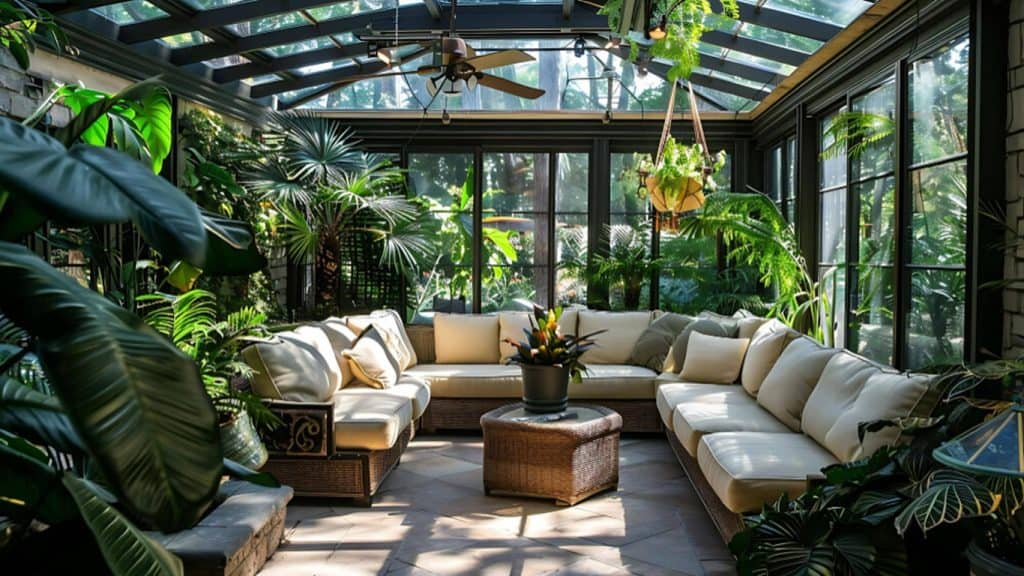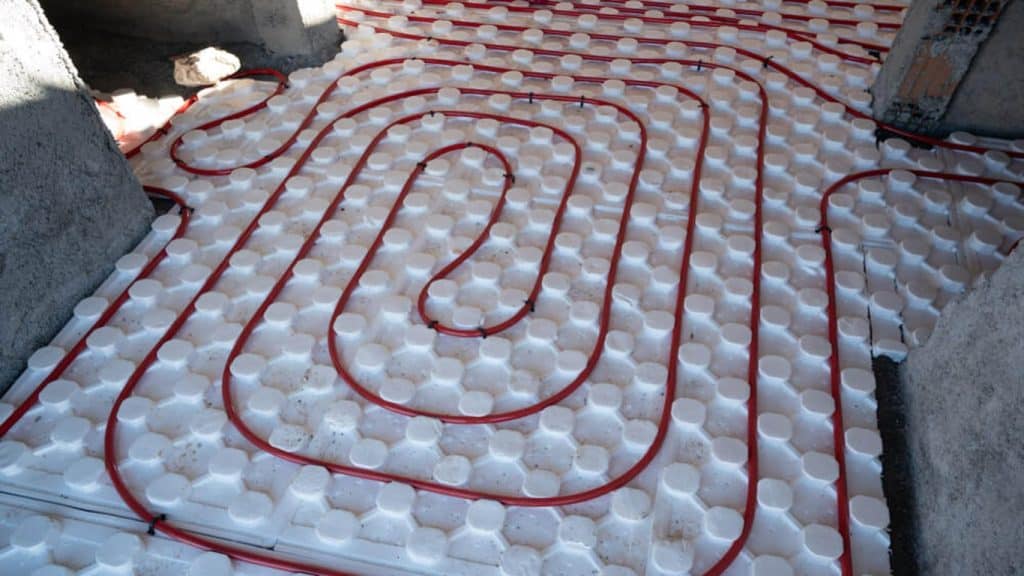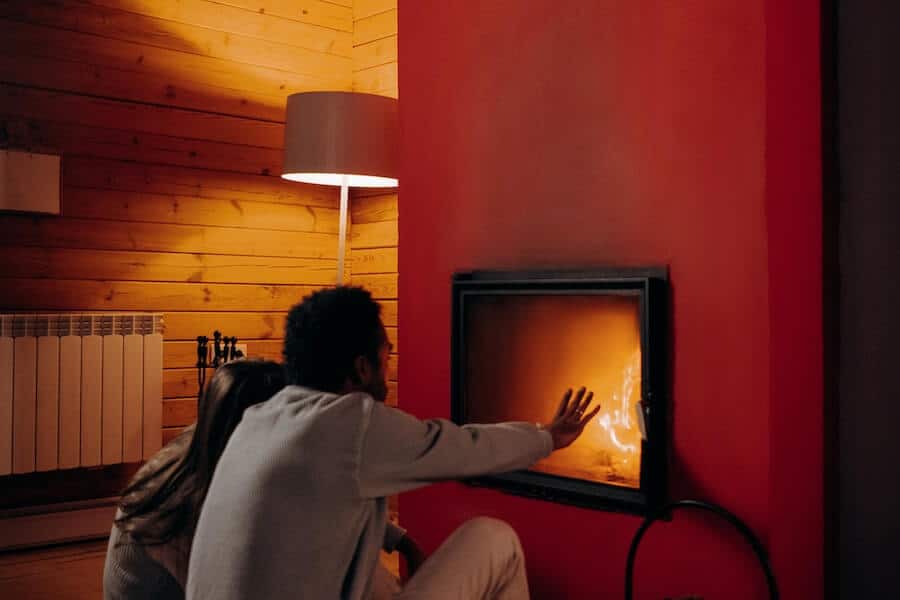
Transform your garden room into a cosy year-round haven with underfloor heating and let comfort rest beneath your feet. Learn about other efficient garden room heating systems here.
Having an extensive garden allows for plenty of space for other structures, such as sheds or garden rooms. But many wonder about how to heat a garden room properly, especially if you are interested in converting it into a garden office, or a space for social events with friends and family. In this article, we will explore the benefits and considerations of installing underfloor heating in your garden room. Whether it’s a dedicated home office, a creative studio, or a tranquil retreat, underfloor heating offers a seamless blend of comfort and efficiency. Learn how this modern heating solution can improve your space and simplify room layouts without compromising design.
Key Points:
- Investigate the different types of underfloor heating that are ideal for garden rooms.
- Examine the installation process and criteria for selecting the appropriate system for your requirements.
- Explore the financial aspects and long-term advantages of installing underfloor heating.
- Evaluate if underfloor heating by itself can adequately heat your garden room all year round.
- What is a Garden Room?
- Heating Options for Your Garden Room
- Electric Radiators and Panel Heaters
- Electric Underfloor Heating
- Solar Power
- Wood Burners
- Gas Heaters
- Key Considerations When Selecting a Heating System
- Advantages of Underfloor Heating in a Heated Garden Office
- Considerations for Underfloor Heating
- Is Underfloor Heating Enough?
- Will Underfloor Heating Raise Your Flooring?
- How To Control The Temperature In Your Garden Room?
- Retrofitting Underfloor Heating
- Use Underfloor Heating For Your Garden Room Heating
- FAQs
- Sources
What is a Garden Room?
Garden rooms are detached structures located on your property, providing a separate oasis from your main residence. With the rise of remote work trends accelerated by the COVID-19 pandemic, the popularity of these versatile spaces has surged. Originally conceived as heated garden offices, garden rooms now serve multiple purposes, including entertainment hubs, play areas for children, or serene spots for relaxation.
Constructed typically from durable materials like solid wood, composite, glass, or brick, garden rooms offer both aesthetic appeal and functional flexibility. Key considerations for their design include placement and frequency of use, which significantly impact year-round comfort. Proper heating, insulation, and double glazing are essential to make these spaces usable across all seasons, enhancing the overall garden room heating efficiency.
Heating Options for Your Garden Room
When it comes to heating a garden office or any garden room, there are several options that blend functionality with innovation. Here’s how to ensure your space remains a comfortable retreat no matter the weather:
Electric Radiators and Panel Heaters

These heaters are a straightforward solution for garden room heating. Available in models like the oil-filled radiator or glass panel heater, they provide warmth using a mix of radiant and convection heat. Although economical, they might leave the air feeling dry. It’s essential to choose units with an inbuilt thermostat for better temperature control and reduced running costs.
Electric Underfloor Heating

This option is ideal for those seeking consistent and comfortable heat. Electric underfloor heating systems distribute warmth evenly across the floor, making the entire room comfortable without compromising floor or wall space. This method is particularly effective in garden rooms, where space can be at a premium. Underfloor heating is known for its efficiency, operating at lower temperatures and converting every watt of electricity into useful heat right where you need it.
Most manufacturers provide a range of output levels, typically 100W/m², 150W/m², and 200W/m². For a garden room with good insulation, an output of 100W/m² may be adequate. The primary distinction between these options is their responsiveness. Higher output levels can warm up the space more quickly.
Solar Power

Integrating solar panels can be an eco-friendly way to power heating in your garden room, though this requires careful consideration of the room’s orientation and roof design. A pitched roof may be necessary for optimal solar panel installation, which could affect planning permissions due to height restrictions.
Wood Burners

Wood burners are not just heating elements; they add a touch of elegance to any space. They are efficient in heating up quickly and retaining warmth, making them a perfect choice for a heated garden office.
Sustainable heating and fuel sources can make wood burners carbon-neutral, aligning with eco-friendly practices. However, the cost of a high-quality wood burner and its installation can be significant. It is crucial to have a certified HETAS engineer install the system to ensure safety and compliance, following which a HETAS Certificate of Compliance will be issued.
Gas Heaters
Gas heaters provide a straightforward solution for garden room heating, especially where there is no access to electrical power. These heaters are portable and do not require permanent installation costs, though they are somewhat bulky due to the gas cylinder they house.
To ensure safety, it’s important that your garden room is well ventilated while using a gas heater to prevent the build-up of condensation and harmful fumes. Additionally, installing a carbon monoxide alarm is essential to detect any potential leaks.
Key Considerations When Selecting a Heating System
- Size and Usage of the Garden Room: The dimensions of your garden room and how you plan to use it will dictate the heating requirements. A smaller room used as an office might need less heating compared to a larger space intended for a garden gym.
- Frequency of Use: For those using their garden room sporadically, smart technology allows for remote heating control—a convenient feature for heating the space only when needed. Conversely, for daily use, such as in a 9-5 office setup, a programmable heating control might be more appropriate, providing consistent temperature throughout the day.
- Insulation Efficiency: Effective insulation is crucial for maintaining a comfortable temperature year-round. Most garden rooms in the UK are equipped with insulation in the floors, walls, and roofs. The effectiveness of insulation is often indicated by its u-value, which measures how well it prevents heat from passing through. A lower u-value means better insulation, leading to better heat retention and reduced heating costs.
- Room Orientation and Solar Gain: The position of your garden room affects how much sunlight it receives, which can significantly influence its internal temperature. Rooms with extensive glazing or those positioned to capture more sunlight will naturally be warmer. This solar gain can be an advantage in winter but may require consideration for cooling in summer months.
Advantages of Underfloor Heating in a Heated Garden Office
Unsure on whether you should add underfloor heating to your garden room or office? Here are our recommendations on why it will benefit you:
- Saving Space
In garden rooms, where every square inch counts, traditional radiators can become obstructions, not just occupying precious wall space but also limiting how furniture is arranged. Underfloor heating liberates all that space. By installing a heating system beneath the floor, you effectively remove any barriers to furniture placement, allowing for a cleaner design and more efficient use of space. With a garden room, it is best to use water underfloor heating during the installation rather than electric underfloor heating as this would mean removing the floorboards which might damage the overall structure.
- Uniform Heat Distribution
Unlike traditional heating systems that create zones of varying temperatures, underfloor heating ensures a consistent warmth across the entire floor surface. This method eliminates the discomfort of colder spots, which is often a drawback with conventional radiators. The warmth radiates upward and distributes evenly, maintaining a stable temperature throughout the garden room.
- Comfort and Warmth
The appeal of stepping onto a warm floor, especially in a garden office used during colder months, cannot be overstated. Underfloor heating brings a comforting warmth to popular flooring options like laminate, hardwood, and tiles, which are often cold underfoot. This feature adds an extra layer of comfort to your garden office, making it a cozy place to work.
Considerations for Underfloor Heating
Investing in underfloor heating involves an initial setup cost that can be higher than other heating options, such as wood burners or electric heaters. The installation process might also be more complex, depending on whether it’s being retrofitted or included in the initial construction of the garden room. However, the long-term benefits in terms of energy efficiency and space utilization often justify the upfront expenditure.
One potential drawback of underfloor heating is its responsiveness. It generally takes longer to heat up than traditional radiators. This delay can be a factor if quick heating is needed, as the system typically takes 30 minutes to an hour to reach the full temperature. However, once it is warm, it retains heat effectively, which can be more energy-efficient for prolonged use, particularly in a well-insulated garden office.
Is Underfloor Heating Enough?
A well-designed underfloor heating system is capable of being the sole heat source in a well-insulated garden room. It eliminates the need for supplementary heating sources, thereby saving space and energy. Matching the system’s power output to the room’s size and insulation quality is crucial to ensure it operates efficiently without the need for additional heaters.
Will Underfloor Heating Raise Your Flooring?
Concerns about underfloor heating raising the floor level significantly are common, especially in garden rooms where ceiling height might be restricted. Fortunately, electric underfloor heating systems are designed to be unobtrusive, typically adding less than 7mm to your floor height. This minimal increase is due to the thin nature of the heating elements and the insulation layer, which also acts as the underlay replacement, further minimizing the impact on the floor elevation.
How To Control The Temperature In Your Garden Room?
The efficiency of underfloor heating in your heated garden office largely depends on the control system used. Modern thermostats offer sophisticated scheduling capabilities, allowing you to program your heating preferences for an entire week, maintaining a consistent temperature between 19°C and 21°C. With the advent of smart home technology, WiFi-enabled thermostats now enable you to adjust your garden room heating from your smartphone, providing convenience and energy efficiency by heating the space only when needed.
Retrofitting Underfloor Heating
Is it too late to install? If you’re contemplating adding underfloor heating to an already constructed garden room, retrofitting is definitely feasible, though it’s simpler if done during initial construction. The process involves raising the existing floor, which can vary in complexity depending on the floor covering. Carpets and laminate floors might be more forgiving, whereas tiles might require more extensive work. This retrofitting can allow for the installation of underfloor heating without significant disruption or alteration to the existing structure, ensuring your garden office remains warm and inviting all year round.
Use Underfloor Heating For Your Garden Room Heating
In conclusion, underfloor heating presents an excellent option for heating a garden office, offering efficient space utilisation, consistent heat distribution, and the comfort of warmth underfoot. Whether you’re installing in a new garden room or retrofitting an existing structure, this system can be effectively controlled with smart thermostats for ease of use and energy efficiency. Despite the initial costs and installation considerations, the long-term benefits make underfloor heating a worthwhile investment for any garden room.
Further reading:
Learn more how underfloor heating and other systems can benefit you with these articles –
FAQs
Is it possible to extend central heating to a garden room?
Yes, you can extend your home’s central heating system to include your garden room if it’s feasible. This involves running additional pipework from your main system to the garden room. It’s a more permanent solution that can be efficient, especially if your garden room is well-insulated.
Can portable heaters be used to heat a garden room?
Portable heaters, like oil-filled radiators or fan heaters, can be effective for heating a garden room. They’re affordable and can be moved as needed. However, they may not be the most cost-effective solution for continuous use due to their higher energy consumption.
Sources
HETAS. (2022) Certificate of Compliance. [online] Available at: https://www.hetas.co.uk/consumer/certificates-of-compliance/ [accessed 07/01/2025]
